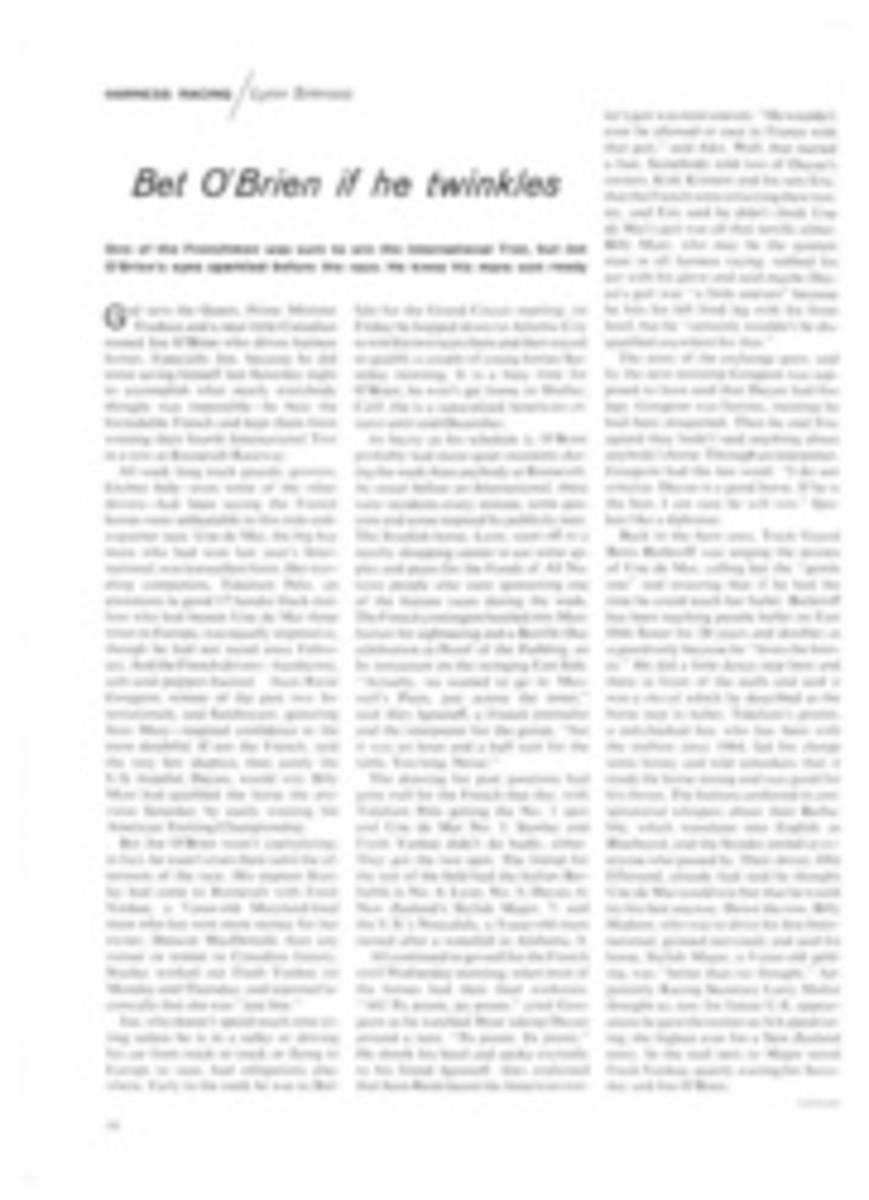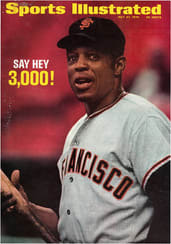
SCORECARD
SNAFU AS USUAL
Every time the AAU gets involved in something, trouble seems to follow, primarily from that creaking organization's uncanny ability to make a mess of things. The latest display of ineptitude occurred in Europe, where a U.S. track and field team had the devil's own time trying to survive in the face of opposition from France, Germany and its own officials (page 47). Athletes, even those not involved in the present rancorous dispute, have expressed anger and outrage at the AAU's methods, and hypocrisy, double standards and stupidity are among the epithets that have been applied. With, apparently, good reason.
LABOR AND MANAGEMENT
Last week, as negotiations between National Football League players and owners appeared to be nearing settlement, John Mackey, the massive tight end of the Baltimore Colts who is president of the NFL Players Association, had some comments on the labor dispute. "I know there must be many fringe players who were worried," he said, "but none of them were more worried than me. After all, I'm a football player, too. But they elected me to this job, and I made sure I wasn't going to get taken in by smooth talk. I gave up all my off-season work, took courses in labor law, surrounded myself with the smartest people I could find, and did my homework. Some of the owners were trying to be fair, but I think they thought it would be a breeze, that we would walk in and have a drink and sign a contract. They didn't realize that we were coming prepared. The important thing was to lay down some guidelines and precedents so that in the future players get a fair share of the profits and a decent pension system."
What comprises a fair share was one of the major stumbling blocks to a settlement. An article in the Baltimore Sun quoted a "source close to the negotiations" who claimed that under the existing pension plan and the present performance of the fund (its earnings have averaged better than 10% a year) the owners' proposal would provide a pension of $26,000 a year at 65 for five-year players and $57,000 a year for 10-year veterans. The players' proposal, the source said, would result in a $38,000 pension for five-year men and $84,000 for 10-year men.
DOWN THE HATCH
Those middle-aged Americans who look back on the college days of the 1930s with nostalgia can take heart from Gene Conrad, an offensive guard at the University of Florida. At the annual "variety night" party of campus athletes, he won first prize for zany endeavors by swallowing 51 live minnows topped off with a squirming earthworm.
OLD ORDER PASSING
Both the U.S. Open tennis championships at Forest Hills and the U.S. pro championships at Boston will augment traditional tennis scoring with the sudden-death tie-breaker system long advocated by Jimmy Van Alen, the inventor of VASSS (Van Alen Simplified Scoring System). If a set reaches six-all in games, the players will alternate serves in a best-of-nine-points sequence; the first to gain five points in this postscript wins the set. This eliminates the possibility of marathons like the 25-23 set John Newcombe won from Marty Riessen last year or the famous 18-16 set in the 1949 singles final between Pancho Gonzales and Ted Schroeder. In sudden-death tennis, no set can go beyond the odd-looking score of 7-6.
Not everyone likes the idea. Rod Laver, defending champion at both tournaments, says, "Sudden-death isn't fair. Nobody ever consults the players, who all hate it. We recognize the need for some form of tie-breaker, but the best-of-nine system gives one player five serves and the other four. Obviously, the bloke with the first serve has a terribly unfair advantage." Officials, on the other hand, are convinced that spectators will love the new system, and they hope television will, too, now that the TV people can be sure no match will last interminably—meaning past scheduled air time.
Despite Laver's objections, the new system is probably as fair as one can be, and it certainly is modern and progressive and efficient. Still, it is sad to think that long-drawn-out matches between titans of the court are a thing of the past. They may have messed up TV schedules but, like an extra-inning baseball game, sometimes they became almost unbearably exciting.
NOT SO GRAND
John Wesley Powell made the first float trip through the Grand Canyon in 1869, and in the next 80 years no more than 100 people were able to emulate his feat. But since 1955, when an enterprising woman named Georgie White took a party of 30 people through the canyon on Navy surplus rafts lashed together, the spectacular 280-mile trip has become commonplace, a commercial venture. By 1968, there were 4,000 tourists floating through the canyon. Last year the total was 6,700. This year it is expected to be between 8,000 and 10,000.
Vast as it is, the Grand Canyon cannot sustain that many visitors. There are only four pit toilets along the river. Driftwood for fires is disappearing and the few sandbars available for campsites are contaminated with all kinds of debris. The 100,000 cubic-feet-per-second Hoods that once cleansed the river are no more; dams have regulated its flow to around 16,000 cubic feet. The Park Service has put a ceiling on the number of permits for commercial river runners, but it may be too late. "They've barred autos from some areas of Yosemite," says Senator Barry Goldwater. "It won't be long before they'll have to bar commercial boats from the Colorado."
FOR TWO CENTS
Maybe the Grand Canyon should adopt a clean-up technique used with overwhelming success in Skagit County, Wash. The First Federal Savings and Loan Assn. of Mount Vernon, the county seat of Skagit County, announced on July 3 that on July 11 it would pay 2¢ for old cans and bottles picked up along country roads. E. W. Mersereau Jr., president of First Federal, figured that as many as 25,000 cans and bottles might be turned up, maybe even 50,000, but on payoff day the line of pedestrians, station wagons, sedans, convertibles and pickup trucks stretched for five miles. When the count ended, 551,762 cans and bottles—or about 10 for every resident of the county—had been turned in. The cost to First Federal came to $11,035.24, instead of the $500 to $1,000 it had anticipated, but bank officials insisted, "It's the best $11,000 we ever spent." Rex Wilson, an assistant vice-president of the bank, said, "We're thrilled to death. I've driven miles and miles and I haven't seen a single beer can anywhere. We're pleased to hear that other communities and businesses are interested in the idea and plan to pick it up."
SERVICES RENDERED
In a burst of chauvinistic generosity, alumni and friends of Kansas State University underwrote the expenses of a Hawaiian vacation this summer for Cotton Fitzsimmons, who coached K-State to the Big Eight basketball championship last winter. But when July came and Fitzsimmons and his wife were out there basking on the beaches of Hawaii, the Kansas State boosters could not help but wince a little, since in June Fitzsimmons had resigned suddenly to take over as head coach of the Phoenix Suns. On his return from Hawaii, the coach, a man of aplomb, said, "I figured they were rewarding us for something I had already done. If they did it for bribery purposes to keep me at Kansas State, well, I guess they just lost."
REMEMBER ME
At the National Four-Ball golf championship this week most of the top pros are teamed with other top pros, but Lee Trevino—wouldn't you know it?—is playing with somebody named Urshell Whittendon. Urshell Whittendon is a rabbit on the tour and not a very successful rabbit. At last report he had appeared at 12 tournaments this year, failed to qualify seven times, qualified but withdrew (presumably because of poor scores) twice, and qualified but failed to make the cut the other three times. Batting average: .000. Why in the world did Lee Trevino pick such a fringe player as a partner? Well, Urshell Whittendon may be a nothing to you, but if you knew that his nickname is Jesse you might remember him as an outstanding defensive back a few years ago with the Green Bay Packers under Vince Lombardi. You might even recall that Jesse Whittendon and his cousin own a golf course called Horizon Hills outside El Paso, Texas, and that they were the ones who gave Lee Trevino his first job as a club pro. Trevino remembers, but then one of the nicest things about Trevino is his memory.
ILLUSTRATION
THEY SAID IT
•Bill Giles, Philadelphia Phillies vice-president, on possible refinements for the electronic scoreboard in the new stadium the Phils expect to occupy next spring: "Picture this pole in center field. Hanging on the end of the pole is the Liberty Bell. At the bottom of the pole, holding a hammer, is a Ben Franklin-looking fellow. Boom. Deron Johnson hits a home run. Somebody presses a button, there's some appropriate music and this Ben Franklin zips up the pole—electronically controlled, of course. He belts the Liberty Bell with a hammer and, wait a minute now, the bell cracks just like the real one."
•Ray Fosse, Cleveland Indians catcher, after he suffered a shoulder injury and was momentarily stunned when Pete Rose crashed into him in a successful effort to score the winning run in the 12th inning of baseball's All-Star Game: "Well, that's football."

